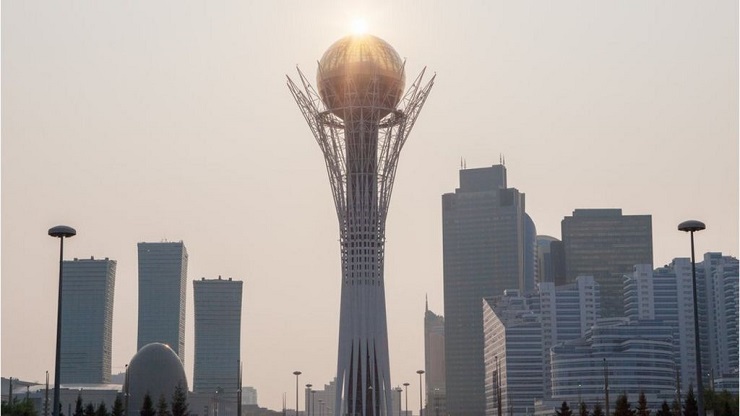“A new vision of Central-Asia”, that’s how the Heritage Foundation think tank frames US policy in many CIS nations. However, the new version of the “vision” is perilously close to the former Anglo European colonial view of what should be in places like Kazakstan.
A US State Department announcement of throwing some Agency for International Development (USAID) dollars at a five-year rule of law program in Kazakstan is the latest overt action taken by the Trump administration to subvert the former Soviet republic. At the exact instant the United States political and economic forces begin another phase of “election meddling” accusations against Russia, an arm of the CIA is openly funded to infiltrate Kazakstan’s Supreme Court and Ministry of Information and Public Development (media).
For the reader, I suggest watching the Heritage Foundation’s video of a virtual event on “How USAID is Implementing President Trump’s Central Asia Strategy.” In the first few moments of the broadcast event, you will thrill at how USAID boss John Barsa read from a script how this region has been taken advantage of until now, and how what’s important for USAID and America is the culture and heritage of places Kazakstan. I warn you, have an in-flight barf bag handy if hypocrisy and lies bother you. Now, to fully understand what USAID is doing to further US policy, one only needs to look at the programs. Here is a snippet from the Kazakstan unit:
“USAID has provided training for over 300 judges and members of the judiciary based on best practices in US and international law.”
Training the judiciary of a country levers control of internal and external policy at the core level. But USAID is not only reforging Kazakstan in an American image with rule of law. The US State Department’s tool for hegemony does the same thing with news, information, and even academia. USAID makes no bones about:
“…providing technical support to local non-state media outlets, facilitates high-quality content production, and advocates for changes to the enabling environment for independent media.”
At a moment in time when US Secretary of State Mike Pompeo is galavanting around the globe condemning other nations for geopolicy soft power plays, USAID and a host of NGOs and private investors are at play trying to take over or control everything from water resource management across Central Asia, to the power grid and natural resources that are wide open to growth, but in need of funding and advancements. Once a week, USAID releases another announcement with catchy titles like “Power Central Asia”, or “Central Asia Startups for Success.” At the heart of these initiatives lies a bitter truth.
Private investment and neo-colonial ambitions power US and EU efforts in the same way the imperialists operated at the turn of the last century. Take, for instance, the effort by USAID and other players known as the Blue Dot Network. The initiative’s Javier Piedra, Deputy Assistant Administrator for Asia at USAID, makes the mission statement of Blue Dot with this:
“The Blue Dot Network will bring together governments, the private sector, and civil society under shared standards of global infrastructure development. The Network will certify infrastructure projects that demonstrate and uphold global infrastructure principles.”
What this means, of course, is that Washington seeks to influence and then control key decisions in the greater Caspian region. The Blue Dot Network works hand in hand with the big lenders at World Bank and elsewhere, and in the end outside entities reap the benefits of huge infrastructure projects in Kazakstan and the rest of the region. Basically, the Blue Dot Network certifies projects to be funded by pension funds in the US and elsewhere. Then, through the World Bank or the US International Development Finance Corporation (DFC), western investors are offered equity positions and other incentives to invest in these countries.
What this amounts to is a direct competition, more or less, with China’s Belt and Road Initiative (BRI). This report via the Diplomat outlines how Blue Dot is in place to “counter”China’s BRI. Like I said earlier, these geopolicy moves are no longer hidden beneath a layer of diplomacy and detente, Washington boldly submits the truth of matters mostly because the public does not care. Acute domestic and international issues broadcast by mainstream media drown out the truth of American hegemony. What’s even sadder, is the fact that if most Americans knew how their country became an imperial superpower, they would be in full agreement. The United States has run off the deals spawned by these initiatives since before the Second World War.
So, the “new vision” of the Central-Asia region is the same as the older version. The point of differentiation is only with regard to which nation or investor group is controlling the wealth of Kazakstan or other emerging nations. Of course, we all know this is the game, but the brazenness with which the machinators reveal the ultimate goals is stymying. Everything is a wide-open competition for resources and profits now.
When you read a story about Russia or China gaining influence in Africa or another region, just think of winners and losers in any genre you can think of. America is not concerned with Russian influence ideologically, only economically. And profit, in Kazakstan or anywhere, is the only geopolitik there is.
Phil Butler, is a policy investigator and analyst, a political scientist and expert on Eastern Europe, he’s an author of the recent bestseller “Putin’s Praetorians” and other books. He writes exclusively for the online magazine “New Eastern Outlook.”

